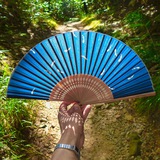It was appointed as a legal prostitution area in 1871 when the Japanese had just started developing Hokkaido and was shut down in 1920 with all brothels relocated elsewhere for the sake of elementary schools and women’s colleges nearby. However, right after WWII many local restaurants started illegally offering adult “add-on” services. This continued even after the Prostitution Prevention Law was passed in 1956, that specifically banned "intercourse with an unspecified person in exchange for payment”. Yet Japanese sex industry is as thriving as ever because such definition allows for a lot of loopholes and interesting interpretations. Nowadays you have an option to pay for a conversation (hostclub, kabakura, girls’ bar), a massage (herusu - health) or even a bath (sopurando - soapland) that can be accompanied by a vast variety of “non-intercourse” sexual acts. But since these shops have to distinguish themselves from normal bars and spa centers, the street facades become extremely important. The most common gesture is the imitation of Western architectural elements that bear a strong connotation of luxury and classiness in Japan. Do you notice any visual patterns in these entrances?
As I said before, the entrance facades in red-light districts are of great importance: they represent the "vibe" of the establishment and give you all kinds of hints about the type of services you're going to get inside. But what happens to the other sides of the building? Well. Nobody. Cares. At all. In Western Europe they have laws to prevent this dystopian wall nightmare from happening; I can vividly imagine my Italian architecture professors writhing in despair when they'll see the pictures. In Japan, on the other hand, the buildings are but a temporary venture. Why should you think about the impression they might make with their side view? It will disappear in 15-30 years and nobody needs nice windows and balconies in a shady hostclub anyway.
Love hotels — another common sight in Susukino. It's very easy to tell them apart from regular hotels by blind windows, wacky facades, unusual colors and hourly rates on display. There is one more interesting pattern though: you almost never see the entrance door from the street. Often there is a wall right in front of the main entrance, so that couples who exit the building can safely say goodbye behind it and go their separate ways without being seen together.
It’s hard finding things to say after a long vacation filled with non-stop visual beauty and emotional events. I am not an impulsive writer so I had to wait for my daily routine to pull my head back to earth and fingers to the keyboard. But now it seems everything is set for this to happen: a big academic publisher gave me a contract to write a book about my danchi research, my abstract was accepted for a mass housing conference in Lisbon, and there’s yet another paper to be published soon that needs lots of editing. Steady daily writing awaits me, and you’ll definitely see more texts here from now on, so let me know if you have any particular topics you wanna read about!
Just a little post about a 1970s house in Niseko I was lucky to stay at. It's common to have double-glazed windows in Hokkaido unlike the rest of Japan, so one would expect a higher level of insulation, but well, the walls are still made of wood and cardboard so it doesn't really help, it's extremely cold. No matter how many square meters you have at your disposal, the functional space will always shrink into a small life-saving volume around your gas heater or a burning stove. In Japan the concept of getting warm is revolving not around the house, but the body itself. Instead of wasting energy on central heating, people take baths, sit around kotatsu, near the stove, air-conditioner or even use chemical hand warmers. European-style heating systems are not welcomed for several environmental reasons (earthquakes are one of them), but maybe there's a cultural concern, too: when it's warm in just one tiny area, you get closer together with the others and it's just cosier that way?
